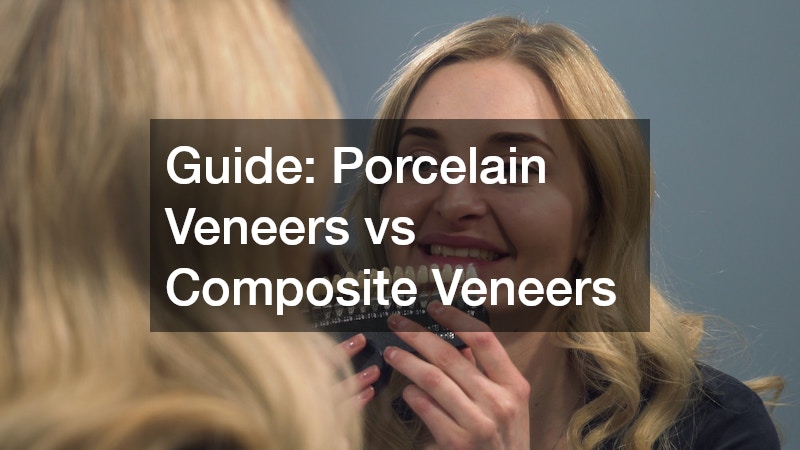
A beautiful smile can make a lasting impression, and veneers are one of the most effective ways to achieve it. Both porcelain veneers and composite veneers can correct chips, stains, or uneven teeth, but they differ in materials, application, and longevity. This guide breaks down how each option works, their pros and cons, and how to decide which is right for your smile.
Porcelain Veneers: The Premium Choice
Porcelain veneers are thin, handcrafted shells of ceramic material bonded to the front of the teeth. They’re known for their durability, natural translucency, and ability to mimic real enamel with remarkable accuracy.
What Makes Them Unique
Porcelain veneers are made from high-quality ceramic that reflects light similarly to natural teeth. They are custom-designed to fit perfectly, providing a seamless, long-lasting finish that resists stains and discoloration.
Treatment Process
Getting porcelain veneers typically takes two visits. During the first appointment, your dentist lightly reshapes the enamel, takes digital impressions, and selects the ideal shade. The veneers are then created in a lab before being bonded in place at your next visit.
Advantages
Porcelain veneers are highly durable and can last well over a decade with proper care. They resist staining from coffee, wine, and smoking, maintaining their brightness for years. Their smooth surface and natural appearance make them ideal for patients seeking a complete smile transformation.
Drawbacks
Because the procedure involves removing a small amount of enamel, it is irreversible. Porcelain veneers are also more expensive than composite alternatives and typically take longer to complete. Repairing a damaged porcelain veneer usually requires a full replacement.
Misconceptions
Many people think porcelain veneers look artificial, but modern designs are ultra-thin and customized to blend perfectly with surrounding teeth. When crafted by a skilled cosmetic dentist, they enhance rather than overpower your natural smile.
Composite Veneers: The Flexible Alternative
Composite veneers provide an affordable, quick solution for improving tooth shape or color. They’re made from a tooth-colored resin that is applied directly onto the teeth, then sculpted, hardened, and polished during the same appointment.
What Sets Them Apart
Unlike porcelain, composite veneers don’t require lab fabrication. The dentist applies and molds the resin by hand, making this option ideal for patients who want immediate results or a reversible treatment.
Procedure Overview
Composite veneers usually take one visit. The dentist lightly buffs the enamel, layers the resin, and uses a curing light to harden it. The final step involves shaping and polishing to create a natural appearance.
Advantages
Composite veneers are cost-effective and easily repairable if they chip or wear down. They require little to no enamel removal and are a good short-term solution for minor imperfections.
Limitations
Composite resin is more porous than porcelain, meaning it can stain over time. It’s also less durable and may need to be replaced every five to seven years. While composite veneers can look excellent, they typically lack the same depth and translucency as porcelain.
Myths About Composite Veneers
Some believe composite veneers are temporary, but they can last several years with good care. Others assume they look less attractive, but when crafted by an experienced dentist, they can still achieve a natural, polished look.
Comparing Strength and Longevity
When it comes to durability, porcelain veneers have the clear advantage. They are stronger, resist staining, and can last up to 15 years or more. Composite veneers, while less expensive, are more prone to wear and discoloration and typically need maintenance or replacement sooner.
Lifestyle and habits also influence how long veneers last. Avoiding teeth grinding, chewing hard foods, and maintaining regular dental visits can extend their lifespan. Both types benefit from good oral hygiene and professional cleanings.
Weighing the Costs
The price difference between porcelain and composite veneers reflects their materials and lifespan. Porcelain veneers cost more initially due to the lab work and craftsmanship involved, while composite veneers offer a lower-cost, same-day option.
Because veneers are considered cosmetic, most insurance plans don’t cover them. However, many dental offices provide flexible payment or financing options. Over time, porcelain veneers may prove more cost-effective since they last longer and resist damage and staining.
Deciding Which Veneer Fits You Best
Choosing between porcelain and composite veneers depends on your goals, budget, and how long you want your results to last. Porcelain is ideal for patients who want a durable, natural-looking smile makeover, while composite veneers suit those seeking a faster, more affordable fix for minor flaws.
Your dentist will evaluate your teeth, bite alignment, and enamel condition before recommending the best option. Lifestyle habits—such as coffee drinking, smoking, or grinding—can also influence which veneer type is most practical for you.
Crafting a Confident, Lasting Smile
Both porcelain veneers and composite veneers can dramatically enhance your smile, but the best choice depends on your needs and expectations. Porcelain offers unmatched beauty and longevity, while composite provides flexibility and accessibility. By consulting an experienced cosmetic dentist, you can find the ideal balance between aesthetics, function, and budget—helping you achieve a healthy, confident smile that truly lasts.

